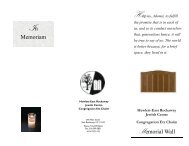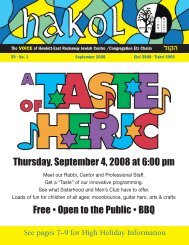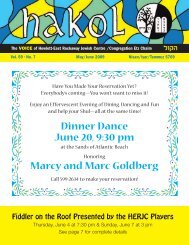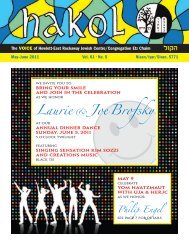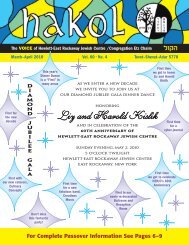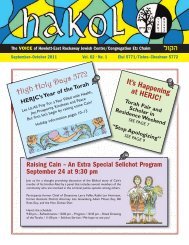1. Hakol March April 2013 - Hewlett E. Rockaway Jewish Center
1. Hakol March April 2013 - Hewlett E. Rockaway Jewish Center
1. Hakol March April 2013 - Hewlett E. Rockaway Jewish Center
You also want an ePaper? Increase the reach of your titles
YUMPU automatically turns print PDFs into web optimized ePapers that Google loves.
our jewish future<br />
nursery school<br />
CHERYL KARP<br />
“The Voice” by Shel Silverstein<br />
There is a voice inside of you<br />
That whispers all day long,<br />
“I feel this is right for me<br />
I know that this is wrong.”<br />
No teacher, preacher, parent, friend<br />
Or wise man can decide<br />
What’s right for you—just listen to<br />
The voice that speaks inside”<br />
I have been best friends with my inner voice for almost<br />
six decades and have learned through the years to<br />
strengthen that voice by listening more closely, hearing<br />
what it truly wants to say, deciding on whether or not<br />
the voice is speaking from an unbiased position due to<br />
its past history to please others, honoring its wisdom of<br />
experience, and allowing it to speak with honesty and<br />
integrity.<br />
Where did that voice of self- judgment come from? It<br />
came about when I was very young, as it does in everyone.<br />
It starts when a person develops the qualities of<br />
memory and logic. Before these two qualities merge, we<br />
stay in the present moment where there is only the<br />
desire and action to express ourselves. You just have to<br />
watch children in our early childhood two year old program<br />
to see the beauty of being able to stay present and<br />
explore life with little to stand in its way. As memory<br />
develops, children begin to recall their parents, for<br />
example, admonishing their behavior for not picking up<br />
the toys, jumping on the couch, hurting someone else<br />
and so much more.<br />
While memory is being developed, so is logic. When<br />
our mind remembers what our parents said the last time<br />
the toys were not put away, logic then kicks in as well.<br />
For example, if a child didn’t pick up toys, memory<br />
would help recall the incident. Logic would then remind<br />
the child how to avoid a parent’s upset and perhaps punishment<br />
by picking up the toys and making the parent<br />
happy. The voice is important as it helps to remind us<br />
what to do in order to be happy. The voice is a rule follower<br />
of other people’s rules. It is this inner voice that<br />
sometimes keeps us from staying present by recalling<br />
what we should and should not do according to other<br />
people’s judgment and hopefully one’s own sense of<br />
right and wrong. It also, however, serves as a Guardian<br />
Angel as it tells us how to stay safe and happy.<br />
Suffice it to say that how we talk to our children<br />
becomes part of their inner voice and self -image. Are we<br />
talking to them with respect, with open mindedness,<br />
with an awareness of developmental behavior, with a<br />
logical explanation as to why rules are put in place for<br />
them, and are adults allowing children to make well<br />
thought out decisions before we impart our own<br />
demand or a command?<br />
In order to help children strengthen their inner voice<br />
while at school, teachers create a stop light approach to<br />
help children figure out for themselves whether or not<br />
they are hearing their inner voice. Some teachers in our<br />
school make a stop light with a green, red and yellow<br />
circle. Each child has a clothes pin with their name on<br />
it. All children start at the beginning of the day with<br />
their clothes pin on the green circle. If a child does<br />
something that steps out of the classroom rules, or<br />
makes a poor judgment as to how he or she treats another<br />
child, the teacher asks the child to correct the behavior<br />
by doing what the child thinks is the right way to<br />
behave. If the child does not correct it, they must move<br />
their clothes pin into the yellow circle. The teachers give<br />
the child another chance to figure out how to correct the<br />
behavior by thinking out loud as to what would have<br />
been a better choice. Making children think of the correct<br />
way of acting in a social and school setting without<br />
our input, develops the child’s inner voice. We have yet<br />
to see any child reach the red circle. Children inwardly<br />
know what they need to do and we educators trust that<br />
page 20 MARCH/APRIL <strong>2013</strong> www.herjc.org<br />
HAKOL







